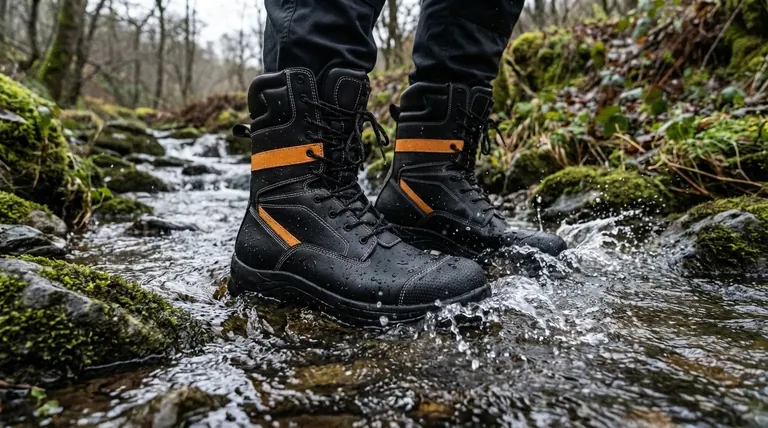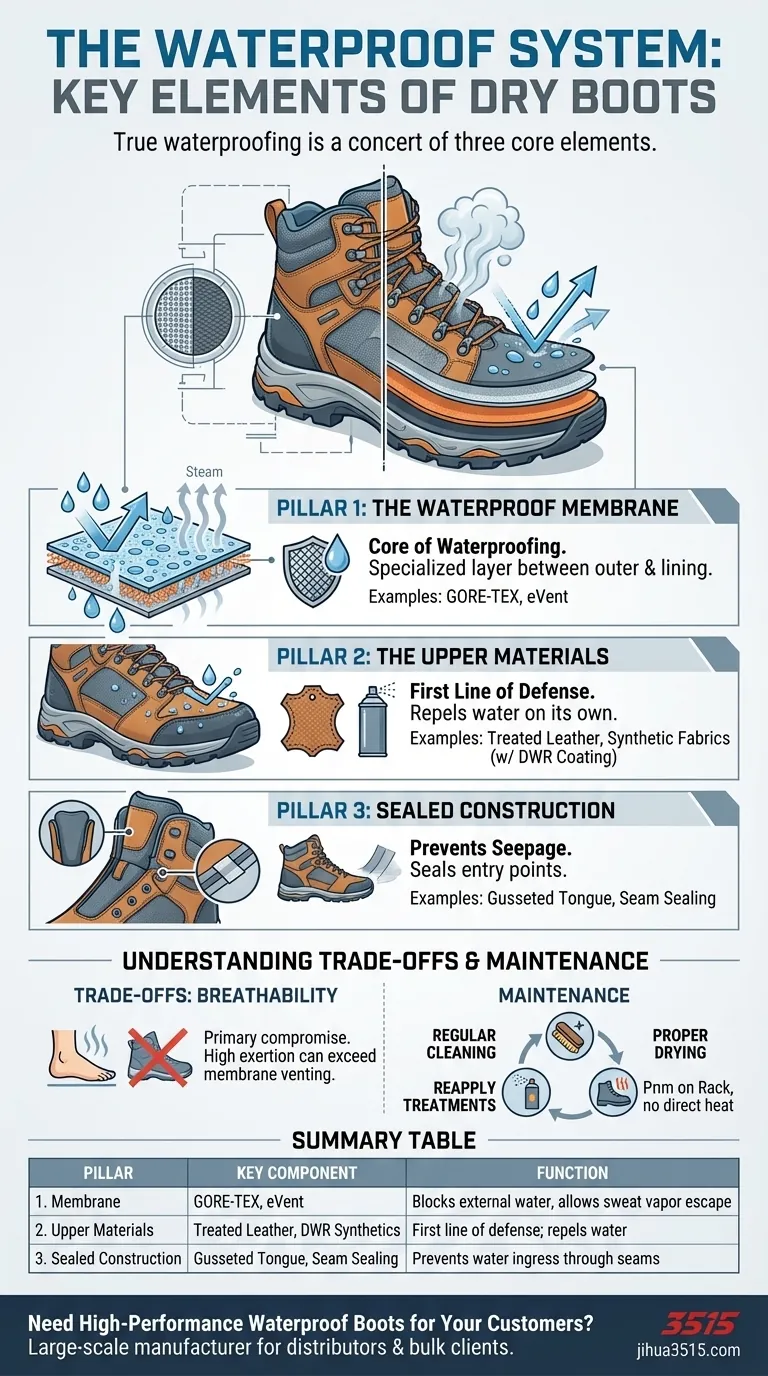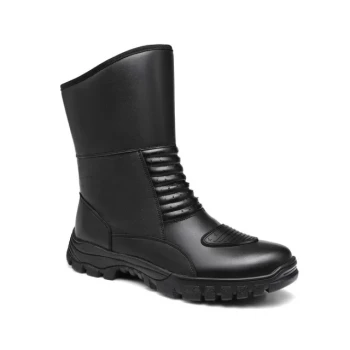Truly waterproof boots are a system, not a single feature. They achieve this through a combination of three core elements: an internal waterproof membrane, water-resistant upper materials, and a sealed construction that prevents water from seeping through seams and openings. Each part must work in concert to keep feet dry from both external water and internal sweat.
The critical distinction to understand is between "water-resistant" and "waterproof." While treated materials can shed water, a dedicated internal membrane like GORE-TEX is the component that provides true, lasting waterproof performance while allowing your feet to breathe.

The Three Pillars of Waterproofing
A boot's ability to keep you dry depends on a multi-layered defense. Viewing these layers as a system is the best way to understand how they function.
Pillar 1: The Waterproof Membrane
The waterproof, breathable membrane is the core of modern waterproof footwear. This is a specialized layer, often a bootie, situated between the boot's outer material and the inner lining.
Prominent examples include GORE-TEX and eVent. These membranes are engineered with microscopic pores that are too small for liquid water droplets to penetrate but large enough for water vapor (sweat) to escape.
This technology solves the primary challenge of waterproofing: preventing water from getting in while also preventing your feet from getting soaked by their own sweat.
Pillar 2: The Upper Materials
The outer material of the boot, known as the upper, serves as the first line of defense. While the membrane does the heavy lifting, the upper is designed to repel as much water as possible on its own.
Common materials include treated leather, such as full-grain or oil-tanned leather, which has natural water-repellent properties that are enhanced with waxes or oils.
Synthetic fabrics and waxed canvas are also used. These materials are almost always treated with a Durable Water Repellent (DWR) coating, which causes water to bead up and roll off the surface.
Pillar 3: Sealed Construction
Even the best materials will fail if water can enter through the boot's construction points. Waterproof boots employ specific techniques to create a sealed vessel around your foot.
A gusseted tongue is a crucial feature where the tongue is attached to the upper along its sides. This creates a continuous barrier that prevents water, snow, and debris from entering through the lace area.
Seam sealing is another vital process. The tiny holes created by stitching seams are a primary weak point. In waterproof boots, these seams are sealed from the inside with waterproof tape to eliminate leaks. Designs that use a single piece of material (one-piece construction) are inherently more water-resistant because they have fewer seams.
Understanding the Trade-offs
No technology is without its compromises. Understanding the limitations of waterproof boots is key to choosing the right pair and using them effectively.
The Critical Role of Breathability
The primary trade-off with any waterproof gear is breathability. A completely impermeable boot, like a basic rubber wellington, will trap all moisture.
While waterproof membranes are designed to be breathable, their effectiveness can be limited. In very warm conditions or during high-exertion activities, you can produce sweat faster than the membrane can vent it, leading to damp feet.
Durability and Maintenance
The waterproofing system is not invincible. The DWR coating on the upper will wear off over time due to abrasion, dirt, and use, causing the outer material to "wet out" or become saturated.
While this saturated outer layer may not leak (thanks to the membrane), it will feel cold and heavy, and it will severely reduce the boot's breathability. This is why regular maintenance is essential.
How to Maintain a Waterproof System
Proper care is necessary to preserve the performance of your boots. Think of it as maintaining a system, not just cleaning a shoe.
Regular Cleaning is Non-Negotiable
Dirt and grime are the enemy of waterproofing. Caked-on mud can physically abrade the DWR coating and clog the pores of a breathable membrane, compromising its function. Always wash mud and debris off your boots after use.
Proper Drying Techniques
Always dry your boots at room temperature in a well-ventilated area. Never place them next to a direct heat source like a radiator, fireplace, or heater. Intense heat can damage leather, melt adhesives, and ruin the delicate waterproof membrane.
Reapplying Protective Treatments
When you notice water is no longer beading on the surface of your boots, it's time to reapply a waterproofing treatment.
Use a product designed for your boot's material. Waterproofing sprays are generally best for synthetic fabrics and suede, while waxes or balms are effective for most types of leather. Be aware that heavy waxes can sometimes reduce the breathability of membrane-lined boots.
Making the Right Choice for Your Goal
Select your boots based on their intended use and the conditions you expect to face.
- If your primary focus is maximum protection in extreme wet conditions (e.g., crossing streams, heavy rain): Prioritize boots with a proven waterproof membrane, a high cuff, and a gusseted tongue.
- If your primary focus is all-day comfort during strenuous hikes: A boot with a high-quality breathable membrane is essential to manage sweat and prevent internal moisture buildup.
- If your primary focus is maintaining your current boots: Regularly clean them and reapply a waterproofing treatment appropriate for the material every few months or after heavy use.
By understanding these components as a complete system, you can confidently select and maintain footwear that keeps you dry, no matter the conditions.
Summary Table:
| Pillar | Key Component | Function |
|---|---|---|
| 1. Membrane | GORE-TEX, eVent | Blocks external water while allowing sweat vapor to escape (breathability). |
| 2. Upper Materials | Treated Leather, Synthetic Fabrics | First line of defense; repels water with DWR coatings. |
| 3. Sealed Construction | Gusseted Tongue, Seam Sealing | Prevents water ingress through seams and openings. |
Need high-performance waterproof boots for your customers?
As a large-scale manufacturer, 3515 produces a comprehensive range of durable and truly waterproof footwear for distributors, brand owners, and bulk clients. Our production capabilities encompass all types of boots, integrating advanced membranes and sealed construction techniques for maximum protection and comfort.
Let us help you equip your customers with reliable footwear for any condition. Contact our team today to discuss your manufacturing needs.
Visual Guide

Related Products
- Premium Flame-Retardant Waterproof Safety Boots and Shoes
- Premium High-Cut Waterproof Safety Boots Manufacturing & Wholesale Solutions
- High Performance Fire-Retardant Waterproof Safety Boots
- Heavy-Duty Waterproof Nubuck Safety Boots Safety Shoes for Bulk Supply
- Premium Wholesale Waterproof Safety Boots High Performance Protection for Industrial Markets
People Also Ask
- What features make oilfield safety shoes resistant to heat and flames? Protect Against Extreme Temperatures
- What is the impact of incorrect specification on safety boots? Avoid Costly Injuries and Non-Compliance
- What are the benefits of proper safety footwear beyond physical protection? Boost Productivity & Morale
- What potential foot injury hazards exist in workplaces? A Guide to Mitigating Common Risks
- What factors should be considered when choosing the appropriate type of safety footwear? A Guide to Maximum Protection



















